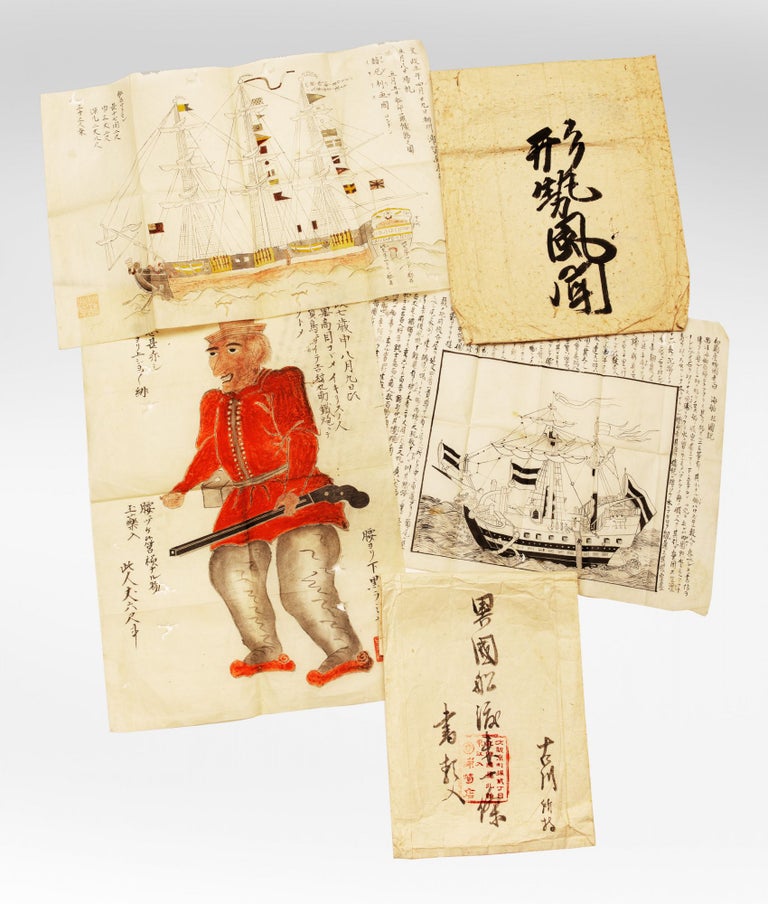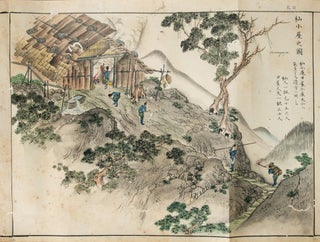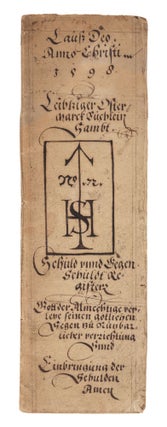
Pivotal Moments in Japan’s History
A group of drawings & Japanese internal government communiqués on foreign incursions.
Three large folded sheets & two lengthy letters with their original manuscript envelopes. Japan: ca. 1822-31.
An exceptional collection of documents on two consequential early Western visits to Japan in the 1820s: the first landing of the Saracen at Uraga and the Takarajima incident. During this period, accounts of these incursions were kept top-secret as matters of Japanese national security. Pre-Commodore Perry materials, such as ours, are extremely scarce. This collection also contains well-rendered drawings of foreigners and their ships. The letters sent by government officials speak to the widespread anxiety throughout the country in the face of much more frequent sightings and occasional landings of Western ships.
Historian David L. Howell writes in his article “Foreign Encounters and Informal Diplomacy in Early Modern Japan” that beginning in 1820 “the number of foreign vessels that approached the coast of Japan surged, the result of an influx of whalers working the so-called Japan Grounds, an area of the northwest Pacific rich in cetacean life…Whereas sightings of foreign vessels had been exceedingly rare throughout Japan before the whalers moved in, afterward they became almost commonplace” (p. 301).
Two significant episodes are touched upon in this archive. The first involves the Saracen, an English whaler, which anchored at Uraga in 1822 (and would also reappear offshore in 1824). The Japanese did not allow the crew to disembark but provided the ailing men with supplies, following established policy. Our archive includes a contemporary ink drawing of the Saracen, annotated with information on the vessel’s crew of 34, and its appearance in Uraga Bay on 29 April 1822, and its eventual departure on 8 May. As Howell describes (p. 302), it was an entirely peaceful encounter, unlike the incident at Takarajima, which occurred two years later.
“In the second month of 1825 [the shogunate proclaimed] an order known most commonly in English as the ‘shell and repel’ edict, but which I have rendered here as ‘don’t think twice.’ It supplanted an earlier order, issued in 1791 and revised in 1806, which had instructed local officials to provide foreign vessels with fresh water, food, and fuel, even as it admonished them to avoid trade and remain vigilant in the face of possible violence…
“The shogunate formulated the new policy specifically in response to…a subsequent encounter with a British vessel. In the seventh month of 1824…men from another English whaler landed on Takarajima, a small island far to the southwest of Kyushu, which belonged to the Satsuma domain. The men tried to barter for cattle, but when that failed they mounted an armed attack on the island, which ended in the death of the leader of the English landing party and the loss of several heads of cattle.”–Howell, p. 309.
The documentation of this incident includes a drawing depicting the slain Englishman, possibly named Stephen Josephson. It is a drawing typical of early Japanese encounters with Westerners. The artist has accentuated his “deep-set” eyes, red hair, large nose, and strange garb. The very tall subject is also holding a firearm.
The remaining manuscripts in this collection include:
–Two long written letters (ca. 1825) from a bakufu official reporting on an English ship that asked for water, firewood, and food and furthermore conducted “aggressive actions.” He expresses grave concern about the growing number of foreign ships sighted offshore.
–An undated sheet recording the estimated distances from Nagasaki to foreign countries, cities, and islands, like Nanjing, Shandong, Fujian, Beijing, Yunnan, Taiwan, Luzon, Cambodia, Sumatra, Jakarta, Madagascar, England, Portugal, Holland, and Russia.
–Manuscript copy of an illustration and text from Oranda sanbutsu zuko (1798), a book by Motoyoshi To about the curiosities and wonders of Holland. An image of a Dutch ship is closely reproduced here on the sheet.
Overall, the collection has been well preserved, but there is some minor worming to the drawings.
❧ David L. Howell, “Foreign Encounters and Informal Diplomacy in Early Modern Japan,” The Journal of Japanese Studies, Vol. 40, No. 2 (Summer 2014), pp. 295-327.
Price: $7,500.00
Item ID: 7711


![From the upper cover: Fried. Krupp Essen A[m]/R[hein]. Deutschland. Friedrich KRUPP, Cast Steel Works.](https://jonathanahill.cdn.bibliopolis.com/pictures/6928.jpg?width=320&height=427&fit=bounds&auto=webp&v=1582901239)

